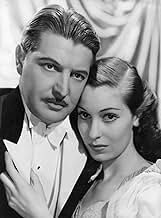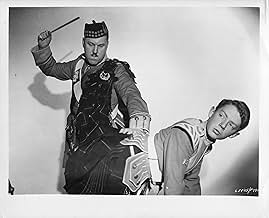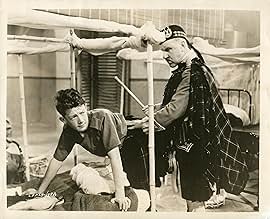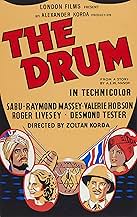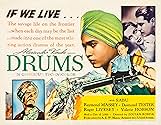Füge eine Handlung in deiner Sprache hinzuDuring the British Raj, Captain Carruthers works undercover to track smuggled shipments of arms on the restless North West Frontier of India. He fears a full-scale rebellion is brewing. To f... Alles lesenDuring the British Raj, Captain Carruthers works undercover to track smuggled shipments of arms on the restless North West Frontier of India. He fears a full-scale rebellion is brewing. To forestall this, the British governor signs a treaty with the friendly, peace-loving ruler o... Alles lesenDuring the British Raj, Captain Carruthers works undercover to track smuggled shipments of arms on the restless North West Frontier of India. He fears a full-scale rebellion is brewing. To forestall this, the British governor signs a treaty with the friendly, peace-loving ruler of Tokot, a key kingdom in the region, which is described as four days' march northward fro... Alles lesen
- Auszeichnungen
- 1 Gewinn & 1 Nominierung insgesamt
- Governor
- (as Francis L.Sullivan)
- Zarullah
- (as Lawrence Baskcomb)
- Sergeant
- (as Julian Mitchell)
Empfohlene Bewertungen
Sir Alexander Korda's London Films was responsible for this lively Technicolor action film which boasted outdoor scenes shot near the North-West Frontier with the assistance of the Mehtar of Chitral. It blends excitement, humor & history - definitely from a British viewpoint - into an attractive package sure to entertain the viewer lucky enough to find it.
Indian actor Sabu stars as the young Prince of Tokot who finds his life suddenly become very dangerous when he's forced to flee his usurping uncle and accept protection from the British Raj. Plummy-voiced Roger Livesey plays the Raj's stalwart envoy to Tokot who must find a way to stop the import of weapons to the evil new Khan, Raymond Massey, who is fomenting a rebellion. All three actors play their parts very well, with Massey especially attacking his villainous role with gusto.
Also in the cast are Valerie Hobson as Livesey's courageous wife; David Tree as a junior officer; and corpulent Francis L. Sullivan as the local Governor in Peshawar. Alfred Goddard appears unbilled as the hapless private Kelly.
*************************
Born Sabu Dastagir in 1924, Sabu was employed in the Maharaja of Mysore's stables when he was discovered by Korda's company and set before the cameras. His first four films (ELEPHANT BOY-1937, THE DRUM-1938, THE THIEF OF BAGDAD-1940, JUNGLE BOOK-1942) were his best and he found himself working out of Hollywood when they were completed. After distinguished military service in World War II he resumed his film career, but he became endlessly confined for years playing ethnic roles in undistinguished minor films, BLACK NARCISSUS (1947) being the one great exception. His final movie, Walt Disney's A TIGER WALKS (1964) was an improvement, but it was too late. Sabu had died of a heart attack in late 1963, only 39 years of age.
Some critics have pointed to the fact that, if this film were made today, it work spark outrage and be roundly condemned. This view ignores that, when the film was first screened in India in the late 30's, it sparked riots among the populace. However, the statement is true as well as being null and void, for there is zero danger of this film ever being made now! The plot is very pro-Empire and it is brazenly flag waving for the British. Looking back now, the film is laughable in it's depiction of it's characters. The British are kind and loving to all the Indians they encounter, while the Indians love them in return; those that don't are, of course, shifty and untrustworthy.
This is rather insulting if you think about it too much - I must admit I wasn't offended but then I am neither English or Indian and know little of the history that is clearly being twisted here in favour of propaganda. The film does have a nice vein of good humour to it though that prevents it being too heavy, while the battle scenes are of the `up'n'over' school of filming. The plot itself is too simplistic and can't keep the charade up - especially now that it will be clear to most viewers that it isn't a fair telling.
The cast are good, but again, there's no way that an `Indian' film would be shot today in Wales with the majority of the cast in blackface! The standout actor is Sabu. True his character is a little too good to be true but he has cheeky attitude and he is good fun throughout - just a shame his character seem to vanish for about a quarter of the film. The villainous Massey is also good fun and I enjoyed his performance. The British (namely Livesey and Hobson) are very stiff, although they do get the more heroic roles towards the end.
Overall this film is worth seeing as we will hopefully not see quite it's like again. The film is un-PC in casting, script, plot and characters, while the history it claims to tell is nothing more than a flag waving exercise that rightly started angry riots in Indian when it was shown there. However it is worth seeing for the period, the glorious (for the time) Technicolor and an amusing and fun performance from Sabu.
The always-excellent Sabu steals the film, as ever, in his role first as a self-possessed princeling and then as a fugitive in exile from his throne; the romantic leads, while well-performed, are less memorable. The tension in the banquet scene is tangible, and Raymond Massey as the usurper brings brains as well as menace to his role. The one element that rather shocked me -- with the exception of the inadvertent glimpse of buttock that reveals exactly what Scotsmen do or don't wear under their kilts! -- was the scene in which the said usurper is shot down by our wounded hero in cold blood, having thrown down his weapon. It's not customary for such an act to be depicted in an apparently approving manner; and certainly not in a film of this period...
I must admit that the question of the period itself had me slightly puzzled, although the mention of syncopation in the drum part for the dance should have given me a clue. I had automatically assumed the story to be set in nineteenth-century India in the heyday of the Raj rather than the contemporary world, and with few European civilian fashions on display, there was nothing to disabuse me of this until the heroine made an appearance in jodhpurs, which came as something of a shock! (And the subconscious resonance with the valleys of 'Carry On up the Khyber' turns out to be based in fact: locations from both were shot in Wales...)
But 'The Drum' is a rousing adventure as they used to make 'em, in the tradition of 'Charge of the Light Brigade' or 'Northwest Frontier'; if you like the genre, this one is a cracker.
As a boy growing up in a small mid-western town, I never missed this epic and its companion feature Four Feathers (1939) in our theater. After all, where else in pre-TV middle America could all that scenic exotica be seen. The be-turbaned Indian natives, the be-skirted English soldiers, the high mountain passes, all in rich Technicolor, along with the rich pageantry of masses of people moving here and there. And shouldn't forget the crackling, if somewhat clichéd, storyline, along with a charmingly youthful Sabu, a gloweringly sinister Raymond Massey, and a slim, long-limbed Valerie Hobson. Then there's that thundering drum, along with slinky native girls and twirling British Highlanders. The Korda's certainly spared no expense and it shows, from spirited opening to satisfying close. Sure, the subtext amounts to British colonial propaganda that no longer wears well. Still, the lavish spectacle remains, a treat for the eye. Of course, I've changed in many ways from those earlier days, but the Korda production can still entertain and impress, if given half a chance.
Wusstest du schon
- WissenswertesThe film caused protests when shown in Bombay and Madras, as it was considered by many to be British propaganda.
- Alternative VersionenVersion shown on Turner Classic Movies from "The Criterion Collection" runs 93 minutes
- VerbindungenFeatured in Family Classics: Family Classics: The Drum (1964)
Top-Auswahl
- How long is The Drum?Powered by Alexa
Details
- Laufzeit1 Stunde 44 Minuten
- Seitenverhältnis
- 1.37 : 1

